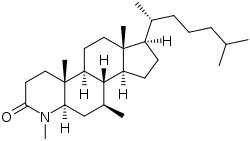MK-386
MK-386, also known as 4,7β-dimethyl-4-aza-5α-cholestan-3-one, is a synthetic, steroidal 5α-reductase inhibitor which was first reported in 1994 and was never marketed.[1][2] It is a 4-azasteroid and a potent and selective inhibitor of 5α-reductase type I and shows high selectivity for inhibition of human 5α-reductase type I over 5α-reductase type II, with IC50 values of 0.9 nM and 154 nM, respectively.[2][3] The drug was under investigation for potential treatment of androgen-dependent conditions such as acne and pattern hair loss (androgenic alopecia or baldness), but was discontinued in early clinical trials due to observations of hepatotoxicity such as elevated liver enzymes.[4]
 | |
| Clinical data | |
|---|---|
| Other names | L-733692; 4,7β-Dimethyl-4-aza-5α-cholestan-3-one[1] |
| Routes of administration | By mouth |
| Drug class | 5α-Reductase inhibitor |
| Identifiers | |
IUPAC name
| |
| CAS Number | |
| PubChem CID | |
| ChemSpider | |
| Chemical and physical data | |
| Formula | C28H49NO |
| Molar mass | 415.706 g·mol−1 |
| 3D model (JSmol) | |
SMILES
| |
InChI
| |
MK-386 has been found to decrease circulating concentrations of dihydrotestosterone (DHT) in men by 20 to 30%,[5] which is in accordance with the fact that 5α-reductase type II is responsible for 70 to 80% of DHT production while 5α-reductase type I is responsible for 20 to 30%.[6] In contrast to MK-386, the selective 5α-reductase type II inhibitor finasteride has been found to decrease DHT levels by about 70%, while the non-selective 5α-reductase inhibitor dutasteride decreases DHT levels by up to 98%.[7] Co-administration of MK-386 and finasteride was found to produce near-complete (~95%) suppression of circulating DHT levels.[8]
MK-386 has been found to significantly decrease concentrations of DHT in sebum, similarly to the selective 5α-reductase type II inhibitor finasteride.[9] However, whereas finasteride results in only a modest reduction in sebum DHT levels of 15%, MK-386 has been found to produce a significantly greater reduction of 55%.[9] While finasteride decreases semen DHT levels by approximately 88%, MK-386 has been found to have no effect on levels of DHT in semen.[9] These findings are in accordance with the known tissue distribution of 5α-reductase isoforms.[10]
MK-386 was assessed in the treatment of acne but failed to separate from placebo in effectiveness and was significantly inferior to antibiotic therapy with minocycline.[11][12] In addition, the addition of MK-386 to minocycline failed to increase effectiveness relative to minocycline alone.[11][12] A study of MK-386 treatment for one year in stumptail macaques found that the drug failed to increase scalp hair weight in a model of androgenic alopecia, in contrast to finasteride.[13][14]
References
- Bakshi RK, Patel GF, Rasmusson GH, Baginsky WF, Cimis G, Ellsworth K, Chang B, Bull H, Tolman RL, Harris GS (1994). "4,7 beta-Dimethyl-4-azacholestan-3-one (MK-386) and related 4-azasteroids as selective inhibitors of human type 1 5 alpha-reductase". J. Med. Chem. 37 (23): 3871–4. doi:10.1021/jm00049a003. PMID 7966146.
- Ellsworth K, Azzolina B, Baginsky W, Bull H, Chang B, Cimis G, Mitra S, Toney J, Bakshi RK, Rasmusson GR, Tolman RL, Harris GS (1996). "MK386: a potent, selective inhibitor of the human type 1 5alpha-reductase". J. Steroid Biochem. Mol. Biol. 58 (4): 377–84. doi:10.1016/0960-0760(96)00050-7. PMID 8903421.
- Bentham Science Publishers (February 1996). Current Pharmaceutical Design. Bentham Science Publishers. pp. 67–.
- Machetti, Fabrizio; Guarna, Antonio (2005). "Novel inhibitors of 5α-reductase". Expert Opinion on Therapeutic Patents. 12 (2): 201–215. doi:10.1517/13543776.12.2.201. ISSN 1354-3776.
- Schwartz JI, Van Hecken A, De Schepper PJ, De Lepeleire I, Lasseter KC, Shamblen EC, Winchell GA, Constanzer ML, Chavez CM, Wang DZ, Ebel DL, Justice SJ, Gertz BJ (1996). "Effect of MK-386, a novel inhibitor of type 1 5 alpha-reductase, alone and in combination with finasteride, on serum dihydrotestosterone concentrations in men". J. Clin. Endocrinol. Metab. 81 (8): 2942–7. doi:10.1210/jcem.81.8.8768856. PMID 8768856.
- Marchetti PM, Barth JH (2013). "Clinical biochemistry of dihydrotestosterone". Ann. Clin. Biochem. 50 (Pt 2): 95–107. doi:10.1258/acb.2012.012159. PMID 23431485.
- Rob Bradbury (30 January 2007). Cancer. Springer Science & Business Media. pp. 49–. ISBN 978-3-540-33120-9.
- E. Nieschlag; H. M. Behre (1 April 2004). Testosterone: Action, Deficiency, Substitution. Cambridge University Press. pp. 586–. ISBN 978-1-139-45221-2.
- Schwartz JI, Tanaka WK, Wang DZ, Ebel DL, Geissler LA, Dallob A, Hafkin B, Gertz BJ (1997). "MK-386, an inhibitor of 5alpha-reductase type 1, reduces dihydrotestosterone concentrations in serum and sebum without affecting dihydrotestosterone concentrations in semen". J. Clin. Endocrinol. Metab. 82 (5): 1373–7. doi:10.1210/jcem.82.5.3912. PMID 9141518.
- Drug Discovery and Design. Academic Press. 18 April 2001. pp. 172–. ISBN 978-0-08-049338-1.
- Leyden J, Bergfeld W, Drake L, Dunlap F, Goldman MP, Gottlieb AB, Heffernan MP, Hickman JG, Hordinsky M, Jarrett M, Kang S, Lucky A, Peck G, Phillips T, Rapaport M, Roberts J, Savin R, Sawaya ME, Shalita A, Shavin J, Shaw JC, Stein L, Stewart D, Strauss J, Swinehart J, Swinyer L, Thiboutot D, Washenik K, Weinstein G, Whiting D, Pappas F, Sanchez M, Terranella L, Waldstreicher J (2004). "A systemic type I 5 alpha-reductase inhibitor is ineffective in the treatment of acne vulgaris". J. Am. Acad. Dermatol. 50 (3): 443–7. doi:10.1016/j.jaad.2003.07.021. PMID 14988688.
- Azzouni F, Godoy A, Li Y, Mohler J (2012). "The 5 alpha-reductase isozyme family: a review of basic biology and their role in human diseases". Adv Urol. 2012: 530121. doi:10.1155/2012/530121. PMC 3253436. PMID 22235201.
- Kaufman KD (2002). "Androgens and alopecia". Mol. Cell. Endocrinol. 198 (1–2): 89–95. doi:10.1016/S0303-7207(02)00372-6. PMID 12573818.
- Kaufman, Keith D. (2001). "5α-Reductase Inhibitors in the Treatment of Androgenetic Alopecia". International Journal of Cosmetic Surgery and Aesthetic Dermatology. 3 (2): 107–119. doi:10.1089/153082001753231036. ISSN 1530-8200.